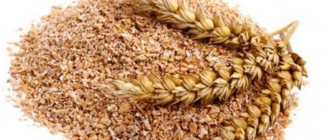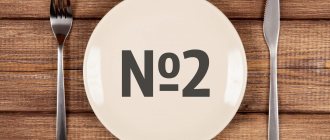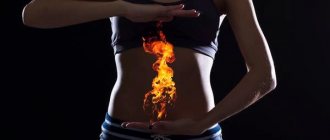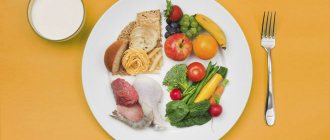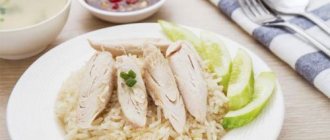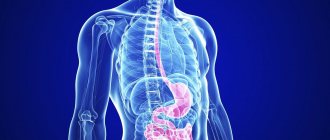The article was prepared by a specialist for informational purposes only. We urge you not to self-medicate. When the first symptoms appear, consult a doctor.
Proper nutrition is considered an important factor in the treatment of many diseases, this is especially true for the pathology of the gastrointestinal tract. Gastroenteritis and other diseases occurring against the background of inflammatory processes require special attention to the patient’s nutrition.
Moreover, about 1/3 of all gastroenteritis develops precisely because of dietary errors. Therefore, diet is the most important condition for recovery. Proper selection and combination of food products will help restore damaged mucous membranes. Diet for gastroenteritis becomes an integral part of treatment (of course, we are not talking about the diet followed by people trying to lose weight, but about the diet that is optimal at a certain stage of the disease, which allows you to speed up the recovery process).
General rules
In the structure of intestinal infections, acute gastroenteritis , often referred to as “stomach flu,” occupies a leading place, especially among children. Despite the polyetiological nature of the disease, the main etiological factor is rota-noro-adeno-enteroviruses . Significantly less common infectious agents are Salmonella , Shigella , Giardia , Clostridia , Proteus , and amoeba dysentery . The disease, as a rule, begins acutely with an increase in body temperature to subfebrile levels and above and lasts 2-4 days. Intoxication syndrome is nonspecific and is characterized by fatigue, weakness, malaise, chills, headache , myalgia .
Almost simultaneously with the intoxication syndrome, patients develop signs of gastroenteritis - rumbling and a feeling of discomfort in the epigastric region, decreased appetite, abdominal pain, nausea, repeated vomiting and frequent loose stools. The main symptom in patients with clinically manifest forms is watery diarrhea with a frequency of 3 to 10-15 times a day depending on the severity of the disease and vomiting, which leads to varying degrees of dehydration and loss of minerals (sodium/potassium).
Treatment of acute enteritis is complex and is aimed in the acute period at combating the pathogen, restoring the water-mineral composition, removing toxic waste products of the infectious agent, relieving the intoxication syndrome and restoring impaired gastrointestinal functions during the recovery period. Diet for gastroenteritis is an essential component of treatment at all stages of the disease and is aimed at providing the patient’s body with necessary nutritional nutrients, sparing the gastrointestinal mucosa, normalizing digestive processes, restoring the biocenosis of intestinal microflora and maintaining immunity . Of particular importance is the diet for gastroenteritis in young children, which is due to varying degrees of immunodeficiency and insufficiency of enzymatic secretion of the gastrointestinal tract.
The basic and general principles of therapeutic nutrition for children with gastroenteritis in the acute period are:
- Reducing the volume of food/increasing the frequency of feedings.
- Temporary exclusion of all types of complementary foods with a gradual expansion of the diet as symptoms subside.
In the acute period, it is necessary to limit the amount of food consumed by 15-50% of the age-specific daily norm, depending on the severity of the disease and the severity of diarrhea syndrome. The frequency of feedings/volume of food per meal depends on age, presence and frequency of vomiting/regurgitation. Thus, for infants with severe diarrhea syndrome and frequent vomiting, the volume of a single feeding varies within the range of 50-80-100-160 ml with the number of feedings, respectively, 10-8-7-6 times a day at intervals of 2-2.5 -3-4 hours. At the same time, it is important to maintain a 6-hour night break.
If the dynamics are positive, from the second day the volume of a single meal must be increased by 25-30 ml daily, bringing it to the age norm on the 4-5th day of the fasting period. During this period, the entire missing volume is replaced with liquid. For children after three years of age, on the first day of treatment, a diet fasting is carried out with kefir at the rate of: 150-200 ml every 4 hours. In severe forms of gastroenteritis, protein deficiency may occur already in the acute period due to malabsorption and loss of amino acids through the intestines. This is typical for children with malnutrition, premature births and those on a starvation diet for a long time, especially with acute intestinal infections accompanied by invasive diarrhea . In such cases, starting from the 3rd day of illness, adapted milk formulas enriched with protein are prescribed, used for feeding premature infants, as well as cottage cheese.
Children over 6 months of age need to combine fermented milk mixtures with 5-10% gluten-free rice/buckwheat porridge cooked in water and vegetable puree with a further gradual expansion of the diet in accordance with the age/nature of feeding of the child before the disease.
In children over 3 years of age in the acute period, until the frequency and nature of stool normalize, all foods/dishes that help stimulate intestinal motility and cause rotting/fermentation processes in it are excluded from the diet - sauerkraut, pure butter/vegetable oil, raw vegetables (radishes, onions, cucumbers, white cabbage, garlic, radishes), plums, pears, some cereals (barley, barley, wheat), strong meat/fish broths, fatty meats/fish, canned food, sausages, legumes, sweet/mineral water and carbonated drinks, whole milk, fresh white/brown bread, baked goods, chocolate, pasta, cocoa.
The salt content in the diet is determined by the severity of diarrhea syndrome and the level of fluid loss. With a slight loss, the salt content is reduced to 8-10 g/day, and with severe dehydration, salt consumption, on the contrary, increases to 20 g/day. During the acute period of gastroenteritis, all dishes are steamed or boiled and served thoroughly pureed or pureed.
The diet must include fermented milk products containing lacto / bifidobacteria , which have the ability to improve digestion and absorption of fats and calcium salts, stimulate intestinal motor/secretory functions, and also have a bactericidal effect on the biocenosis of opportunistic microflora. For this purpose, adapted infant formulas Frisolak , Nutrilon , Tutteli or partially adapted ones ( Malysh , Vitalakt ) can be prescribed, but in severe cases it is preferable to give the child therapeutic and prophylactic products with a probiotic effect - Biolact , Bifikefir , Bifilakt , Lactofidus , Acidolakt .
Bifidobacteria / lactobacteria contained in these products prevent the development of dysbacteriosis , normalize the intestinal biocenosis, and have an immunomodulatory effect. Enfamil , Similak , Frisolak in the diet .
The greatest threat with intestinal flu in children is the development of dehydration . To eliminate it in uncomplicated cases ( exicosis ), glucose-saline solutions for oral rehydration , which makes it possible to relatively quickly restore the water-salt volume (K+/NA+ concentration, indicators of the acid-base state). Glucosalan , Regidron , and Oralit are most often used for this purpose . However, there are more effective drugs - hypoosmolar mixtures ( Humana Electrolyte with fennel , Gastrolit with chamomile extract ), which in a much shorter time stop the symptoms of toxicosis/ exicosis , vomiting, which can reduce the duration of the acute period of gastroenteritis.
After intoxication has decreased and children have developed an appetite, dietary meat (turkey, rabbit, beef in the form of cutlets/meatballs), steam omelet, low-fat fish, fresh pureed cottage cheese, and egg yolk are gradually introduced into the menu. The diet includes slimy cereal soups in non-concentrated chicken broth with well-cooked vermicelli, white bread crackers, and various porridges (with the exception of pearl barley/millet).
It is important to include foods containing pectin (apples, bananas, carrots) in your child’s diet, mainly in the form of purees or baked foods. Pectin has the ability to bind liquid in the intestinal lumen, and the forming colloidal mass, when moving through the intestines, well adsorbs incompletely digested food debris, microorganisms/products of their vital activity. It is also necessary to include in the diet citrus fruits, black currants, cherries, pomegranates, blueberries, which have an astringent effect, and freshly prepared juices and berry jelly. Compotes made from various dried fruits are also useful.
The diet for children after gastroenteritis should last at least 3-4 weeks. If this requirement is not met, there is a high risk of developing chronic enteritis / colitis , since the insufficiency of the digestive/motor/evacuatory function of the intestine continues to persist for a long period. The nutritional menu for children of different ages should be moderately gentle, in small portions with the exception of aggressive foods, as well as those containing coarse plant fiber - fried, smoked meats, fatty meat/fish, legumes, sour foods, confectionery, marinades, ice cream, drinks containing carbon dioxide , essential oils (spices, onions, radishes, garlic, radishes, coffee, chocolate) and food additives (preservatives, dyes, flavor enhancers).
Basics of therapeutic nutrition for gastroenteritis
Gastroenteritis can occur in both acute and chronic forms. The causes of inflammation vary. The disease can be triggered by infections, food, and allergic reactions.
However, there are uniform recommendations for creating a menu for all patients with gastroenteritis:
- Situations in which the mucous membranes of the stomach and intestines are subjected to mechanical or chemical influence should not be allowed.
- You need to eat food that envelops the walls of the stomach and intestines.
- The menu should be balanced. Food for the body is a source of vitamins and microelements.
- Food should not contain bacteria or other pathogenic flora.
It is important to carefully select foods and prepare them correctly. After completion of the acute stage of gastroenteritis, it is prohibited to include fried and fatty foods on the menu for 14 days. Products should be crushed, pureed, and thoroughly boiled.
Children with gastroenteritis should eat properly. Dishes should be made as single components. It is important to exclude sugar and other sweeteners.
Food should be warm; too hot or cold dishes contribute to irritation of the mucous membrane of the digestive system, which will lead to an exacerbation of the pathology.
You need to eat often and in small portions. This will avoid overstretching the walls of the digestive organs, prevent the occurrence of vomiting, and normalize intestinal motility.
Authorized Products
Dietary nutrition for gastroenteritis in children includes white crackers/day-old wheat bread, non-concentrated chicken/vegetable broth and mucous soups with the addition of thoroughly boiled vegetables, rice/buckwheat.
It is recommended to consume lean meat, both red and chicken, turkey, rabbit, mainly in boiled/baked and well-chopped form, in the form of steamed dishes, pates, and cutlets.
Fish is useful, both sea and river low-fat varieties. The diet should include fermented milk products (yogurt without additives, yogurt, kefir), soft-boiled chicken eggs/steam omelet, grated mild cheese, fresh grated cottage cheese, butter/vegetable oils.
For garnish, it is recommended to use well-cooked rice/buckwheat, boiled vegetables and various garden herbs.
It is allowed to include honey, marmalade, and jam in the diet. For drinking, we recommend freshly prepared juices diluted with water, rosehip decoction, weak green tea, still table water, teas based on sage, chamomile, thyme, linden, cranberry/lingonberry juice, dried fruit compotes, purified boiled water with the addition of blueberries and honey.
Table of permitted products
| Proteins, g | Fats, g | Carbohydrates, g | Calories, kcal | |
Vegetables and greens | ||||
| zucchini | 0,6 | 0,3 | 4,6 | 24 |
| cauliflower | 2,5 | 0,3 | 5,4 | 30 |
| carrot | 1,3 | 0,1 | 6,9 | 32 |
| beet | 1,5 | 0,1 | 8,8 | 40 |
| celery | 0,9 | 0,1 | 2,1 | 12 |
| pumpkin | 1,3 | 0,3 | 7,7 | 28 |
| horseradish | 3,2 | 0,4 | 10,5 | 56 |
| sorrel | 1,5 | 0,3 | 2,9 | 19 |
Fruits | ||||
| apricots | 0,9 | 0,1 | 10,8 | 41 |
| avocado | 2,0 | 20,0 | 7,4 | 208 |
| oranges | 0,9 | 0,2 | 8,1 | 36 |
| watermelon | 0,6 | 0,1 | 5,8 | 25 |
| bananas | 1,5 | 0,2 | 21,8 | 95 |
| melon | 0,6 | 0,3 | 7,4 | 33 |
| lime | 0,9 | 0,1 | 3,0 | 16 |
| lemons | 0,9 | 0,1 | 3,0 | 16 |
| tangerines | 0,8 | 0,2 | 7,5 | 33 |
| plums | 0,8 | 0,3 | 9,6 | 42 |
| apples | 0,4 | 0,4 | 9,8 | 47 |
Berries | ||||
| cowberry | 0,7 | 0,5 | 9,6 | 43 |
| strawberry | 0,8 | 0,4 | 7,5 | 41 |
| cranberry | 0,5 | 0,0 | 6,8 | 26 |
| sea buckthorn | 1,2 | 5,4 | 5,7 | 82 |
| currant | 1,0 | 0,4 | 7,5 | 43 |
| rose hip | 1,6 | 0,0 | 14,0 | 51 |
Nuts and dried fruits | ||||
| raisin | 2,9 | 0,6 | 66,0 | 264 |
Cereals and porridges | ||||
| buckwheat (kernel) | 12,6 | 3,3 | 62,1 | 313 |
| cereals | 11,9 | 7,2 | 69,3 | 366 |
| white rice | 6,7 | 0,7 | 78,9 | 344 |
Bakery products | ||||
| white bread crackers | 11,2 | 1,4 | 72,2 | 331 |
Confectionery | ||||
| fruit and berry marmalade | 0,4 | 0,0 | 76,6 | 293 |
Raw materials and seasonings | ||||
| mustard | 5,7 | 6,4 | 22,0 | 162 |
| honey | 0,8 | 0,0 | 81,5 | 329 |
| ground black pepper | 10,4 | 3,3 | 38,7 | 251 |
| milk sauce | 2,0 | 7,1 | 5,2 | 84 |
| sour cream sauce | 1,9 | 5,7 | 5,2 | 78 |
Dairy | ||||
| kefir 1% | 2,8 | 1,0 | 4,0 | 40 |
| curdled milk | 2,9 | 2,5 | 4,1 | 53 |
| acidophilus | 2,8 | 3,2 | 3,8 | 57 |
| yogurt | 4,3 | 2,0 | 6,2 | 60 |
Cheeses and cottage cheese | ||||
| cottage cheese 0.6% (low fat) | 18,0 | 0,6 | 1,8 | 88 |
Meat products | ||||
| boiled beef | 25,8 | 16,8 | 0,0 | 254 |
| boiled veal | 30,7 | 0,9 | 0,0 | 131 |
| rabbit | 21,0 | 8,0 | 0,0 | 156 |
Bird | ||||
| boiled chicken | 25,2 | 7,4 | 0,0 | 170 |
| turkey | 19,2 | 0,7 | 0,0 | 84 |
Eggs | ||||
| chicken eggs | 12,7 | 10,9 | 0,7 | 157 |
Fish and seafood | ||||
| Red caviar | 32,0 | 15,0 | 0,0 | 263 |
| black caviar | 28,0 | 9,7 | 0,0 | 203 |
| chum salmon caviar grainy | 31,6 | 13,8 | 0,0 | 251 |
Oils and fats | ||||
| peasant unsalted butter | 1,0 | 72,5 | 1,4 | 662 |
| corn oil | 0,0 | 99,9 | 0,0 | 899 |
| olive oil | 0,0 | 99,8 | 0,0 | 898 |
| sunflower oil | 0,0 | 99,9 | 0,0 | 899 |
| ghee | 0,2 | 99,0 | 0,0 | 892 |
Non-alcoholic drinks | ||||
| mineral water | 0,0 | 0,0 | 0,0 | — |
| lingonberry juice | 0,1 | 0,0 | 10,7 | 41 |
| green tea | 0,0 | 0,0 | 0,0 | — |
Juices and compotes | ||||
| apricot juice | 0,9 | 0,1 | 9,0 | 38 |
| carrot juice | 1,1 | 0,1 | 6,4 | 28 |
| pumpkin juice | 0,0 | 0,0 | 9,0 | 38 |
| rose hip juice | 0,1 | 0,0 | 17,6 | 70 |
| * data is per 100 g of product | ||||
Fully or partially limited products
Dietary nutrition for acute gastroenteritis in children involves the exclusion from the diet of concentrated meat/fish and vegetable broths and first courses prepared on their basis.
It is prohibited to include in the diet animal fats, sausages, smoked meats, canned food (meat and fish), fresh rye/white bread, fatty red meat, chicken eggs (fried, hard-boiled), poultry meat, fatty sharp cheeses, heavy cream, confectionery cream, sour cream, whole milk.
It is not allowed to eat legumes and all types of cabbage, as they contribute to the development of putrefactive/fermentation processes in the intestines, barley, wheat and pearl barley porridge, dumplings, dumplings, and pasta.
Products that irritate the gastrointestinal mucosa (various seasonings, salty and pickled dishes, ketchups, hot sauces), as well as those containing a lot of coarse fiber, are excluded from the diet.
It is not recommended to consume ice cream, cocoa, chocolate, strong coffee and drinks containing carbon dioxide.
Table of prohibited products
| Proteins, g | Fats, g | Carbohydrates, g | Calories, kcal | |
Vegetables and greens | ||||
| spicy vegetables | 2,8 | 0,5 | 5,3 | 36 |
| vegetables legumes | 9,1 | 1,6 | 27,0 | 168 |
| canned vegetables | 1,5 | 0,2 | 5,5 | 30 |
| swede | 1,2 | 0,1 | 7,7 | 37 |
| cabbage | 1,8 | 0,1 | 4,7 | 27 |
| sauerkraut | 1,8 | 0,1 | 4,4 | 19 |
| cauliflower | 2,5 | 0,3 | 5,4 | 30 |
| bulb onions | 1,4 | 0,0 | 10,4 | 41 |
| cucumbers | 0,8 | 0,1 | 2,8 | 15 |
| canned cucumbers | 2,8 | 0,0 | 1,3 | 16 |
| pickles | 0,8 | 0,1 | 1,7 | 11 |
| radish | 1,2 | 0,1 | 3,4 | 19 |
| white radish | 1,4 | 0,0 | 4,1 | 21 |
| turnip | 1,5 | 0,1 | 6,2 | 30 |
| canned tomatoes | 1,1 | 0,1 | 3,5 | 20 |
| garlic | 6,5 | 0,5 | 29,9 | 143 |
Fruits | ||||
| pears | 0,4 | 0,3 | 10,9 | 42 |
Berries | ||||
| grape | 0,6 | 0,2 | 16,8 | 65 |
Mushrooms | ||||
| mushrooms | 3,5 | 2,0 | 2,5 | 30 |
| marinated mushrooms | 2,2 | 0,4 | 0,0 | 20 |
Nuts and dried fruits | ||||
| nuts | 15,0 | 40,0 | 20,0 | 500 |
Cereals and porridges | ||||
| corn grits | 8,3 | 1,2 | 75,0 | 337 |
| pearl barley | 9,3 | 1,1 | 73,7 | 320 |
| Wheat groats | 11,5 | 1,3 | 62,0 | 316 |
| millet cereal | 11,5 | 3,3 | 69,3 | 348 |
| barley grits | 10,4 | 1,3 | 66,3 | 324 |
Flour and pasta | ||||
| pasta | 10,4 | 1,1 | 69,7 | 337 |
Bakery products | ||||
| Old Russian grain bread | 9,6 | 2,7 | 47,1 | 252 |
| Rye bread | 6,6 | 1,2 | 34,2 | 165 |
Confectionery | ||||
| candies | 4,3 | 19,8 | 67,5 | 453 |
| cake | 3,8 | 22,6 | 47,0 | 397 |
Chocolate | ||||
| chocolate | 5,4 | 35,3 | 56,5 | 544 |
Raw materials and seasonings | ||||
| ketchup | 1,8 | 1,0 | 22,2 | 93 |
| mayonnaise | 2,4 | 67,0 | 3,9 | 627 |
| soy sauce | 3,5 | 0,0 | 11,0 | 58 |
| vinegar | 0,0 | 0,0 | 5,0 | 20 |
Dairy | ||||
| milk 4.5% | 3,1 | 4,5 | 4,7 | 72 |
| cream | 2,8 | 20,0 | 3,7 | 205 |
Meat products | ||||
| pork | 16,0 | 21,6 | 0,0 | 259 |
Sausages | ||||
| dry-cured sausage | 24,1 | 38,3 | 1,0 | 455 |
Bird | ||||
| smoked chicken | 27,5 | 8,2 | 0,0 | 184 |
| duck | 16,5 | 61,2 | 0,0 | 346 |
| smoked duck | 19,0 | 28,4 | 0,0 | 337 |
| goose | 16,1 | 33,3 | 0,0 | 364 |
Fish and seafood | ||||
| dried fish | 17,5 | 4,6 | 0,0 | 139 |
| smoked fish | 26,8 | 9,9 | 0,0 | 196 |
| canned fish | 17,5 | 2,0 | 0,0 | 88 |
Oils and fats | ||||
| animal fat | 0,0 | 99,7 | 0,0 | 897 |
| cooking fat | 0,0 | 99,7 | 0,0 | 897 |
Alcoholic drinks | ||||
| vodka | 0,0 | 0,0 | 0,1 | 235 |
| cognac | 0,0 | 0,0 | 0,1 | 239 |
| beer | 0,3 | 0,0 | 4,6 | 42 |
Non-alcoholic drinks | ||||
| bread kvass | 0,2 | 0,0 | 5,2 | 27 |
| cola | 0,0 | 0,0 | 10,4 | 42 |
| lemonade | 0,0 | 0,0 | 6,4 | 26 |
| Pepsi | 0,0 | 0,0 | 8,7 | 38 |
| sprite | 0,1 | 0,0 | 7,0 | 29 |
| black tea | 20,0 | 5,1 | 6,9 | 152 |
Juices and compotes | ||||
| tomato juice | 1,1 | 0,2 | 3,8 | 21 |
| * data is per 100 g of product | ||||
Reviews and results
Among parents of children who have suffered acute gastroenteritis, positive reviews and a belief in the need for adequate dietary nutrition for a quick recovery of the child prevail.
- “... The daughter brought her granddaughter to her grandmother for the holidays and after 4 days the child began to vomit, feel generally unwell, and a little later, loose stools appeared. The first thought was food poisoning, they washed out my stomach and gave me activated charcoal. But the situation did not improve and by the evening there was a fever, lethargy, and lethargy. She categorically refused food. A local therapist was called to the house and diagnosed rotavirus acute gastroenteritis. They followed all the doctor's orders, gave her plenty of water, and made her drink a saline solution every 30 minutes to rehydrate. They gave rosehip infusion, boiled water, herbal teas with linden and chamomile, still mineral water, and dried fruit compote. On the first day she ate practically nothing. The next day, they started giving me weak chicken broth with vegetables and slimy rice porridge in small portions. On the third day, they began to expand the diet - in addition to soup, they gave chicken breast and boiled fish. The child had no appetite for almost a whole week and only after 8 days did he become interested in food. I added pureed vegetables, grated cottage cheese, a soft-boiled egg, and fermented milk products to the diet. After recovery, I kept the child on a diet for another month.”
Prevention
After completing the course of treatment and to prevent the infection from returning, you should follow simple prevention methods, namely:
- adhere to a proper diet;
- stop smoking, do not drink alcohol;
- eat right and adhere to the diet prescribed by the doctor;
- take medications or traditional medicine on the advice of a doctor;
- follow food storage rules, control the freshness of the dish and the products from which the food is prepared;
- wash food and hands thoroughly;
- Avoid communication with patients who currently have gastroenteritis.
It is also useful to undergo examination of the gastrointestinal tract every six months. If a person adheres to the diet and all medical recommendations, the disease will recede faster and allow a return to a natural lifestyle.

